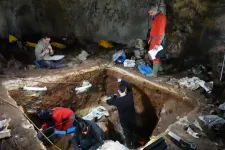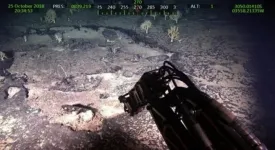Nuclear DNA from sediments helps unlock ancient human history
For the first time, scientists have succeeded in extracting and analyzing Neandertal chromosomal DNA preserved in cave sediments
2021-04-15
(Press-News.org) The field of ancient DNA has revealed important aspects of our evolutionary past, including our relationships with our distant cousins, Denisovans and Neandertals. These studies have relied on DNA from bones and teeth, which store DNA and protect it from the environment. But such skeletal remains are exceedingly rare, leaving large parts of human history inaccessible to genetic analysis.
To fill these gaps, researchers at the Max Planck Institute for Evolutionary Anthropology developed new methods for enriching and analyzing human nuclear DNA from sediments, which are abundant at almost every archaeological site. Until now, only mitochondrial DNA has been recovered from archaeological sediments, but this is of limited value for studying population relationships. The advent of nuclear DNA analyses of sediments provides new opportunities to investigate the deep human past.
Sediments may contain genetic material from other mammals
When extracting ancient human DNA from the sediments, the scientists had to be careful to avoid the considerable amount of DNA from other mammals, such as bears and hyenas. "There are lots of places in the human genome that are very similar to a bear's DNA, for example," said Benjamin Vernot, the first author of the study. The researchers specifically targeted regions in the genome where they could be confident of isolating only human DNA, and they also designed methods to measure their success in removing non-human DNA. "We wanted to be confident that we weren't accidentally looking at some unknown species of hyena," said Vernot.
The scientists applied their techniques to study more than 150 sediment samples from three caves. At two of these -- Chagyrskaya and Denisova Caves in the Altai Mountains of southern Siberia -- previous studies had analyzed DNA from bones. So the authors were able to compare the DNA from sediments to the DNA from bones. "The techniques we developed are very new, and we wanted to be able to test them in places where we knew what to expect," said Matthias Meyer, the senior author on the study. The researchers found that DNA from the sediments was most closely related to genomes retrieved from bones from those sites, giving them confidence in the robustness of their methods.
Nuclear DNA retrieved from cave deposits in northern Spain
Excavations at the third site, Galería de las Estatuas in northern Spain, led by Juan Luís Arsuaga from Universidad Complutense de Madrid, had uncovered stone tools spanning a period between 70 and 115 thousand years ago. But only a single Neandertal toe bone had been found, and it was too small to sample for DNA. "There was no way of studying the genetics of the Neandertals who lived in Estatuas," said Asier Gómez-Olivencia, a scientist on the Estatuas team from Universidad del País Vasco/Euskal Herriko Unibertsitatea. The nuclear DNA extracted from the sediments revealed that not one, but two Neandertal populations had lived in the cave, with the original group replaced by a later group approximately 100 thousand years ago.
When the scientists compared the sediment DNA to other skeletal samples, they noticed a striking trend -- there seemed to have been two "radiations" of Neandertals, with the older Estatuas population stemming from one radiation, and the younger population from a second event. "We wondered if these radiations, along with the population replacement in Estatuas, might have been tied to climate changes, or to changes in Neandertal morphology that occurred around this time period - although we will need more data to say for sure," said Juan Luís Arsuaga.
New insights into the deep human past
Even for sites where studies have previously analyzed DNA from bones, it is possible to glean new insights from the sediments. At Chagyrskaya Cave, earlier archaeological studies had suggested that the Neandertal occupants belonged to a single population, and lived there for only a short time. But as previous work had only recovered a single genome from one of the bones found at the site, there was no way to tell if it was representative of the whole population that lived around Chagyrskaya Cave. The sediment DNA was able to confirm this hypothesis. "We took sediment samples from throughout the stratigraphy, and they all looked very similar to the DNA from the bone, even though the sediment DNA came from multiple individuals," said Kseniya Kolobova at the Institute of Archaeology and Ethnography, Russian Academy of Sciences, the lead archaeologist at Chagyrskaya Cave.
"The dawn of nuclear DNA analysis of sediments massively extends the range of options to tease out the evolutionary history of ancient humans," said Vernot. By freeing the field of ancient DNA from the constraints of finding human remains and expanding the number of sites potentially suitable for investigation, "we can now study the DNA from many more human populations, and from many more places, than has previously been thought possible," said Meyer.
INFORMATION:
Original publication:
Benjamin Vernot et al.
Unearthing Neandertal population history using nuclear and mitochondrial DNA from cave sediments
Science, 15 April 2021
Contact:
Dr. Benjamin Vernot
Max Planck Institute for Evolutionary Anthropology, Leipzig
+49 341 3550-787
benjamin_vernot@eva.mpg.de
Dr. Matthias Meyer
Max Planck Institute for Evolutionary Anthropology, Leipzig
+49 341 3550-509
mmeyer@eva.mpg.de
[Attachments] See images for this press release:

ELSE PRESS RELEASES FROM THIS DATE:
2021-04-15
The widespread proliferation of the internet and information and communication technologies (ICT) has drawn people into urban centres, according to new research.
Despite being able to access data at the drop of a hat or speak face-to-face to people on the other side of the world, the evolution of technological capabilities hasn't led to an exodus from cities. In fact experts at the University of Bristol have found quite the opposite; that the increased adoption of ICT has resulted in national urban systems - cities within a country - that are characterised by higher population concentrations. ...
2021-04-15
A new generation of miniature recording probes can track the same neurons inside tiny mouse brains over weeks -- and even months.
The new tools build on the success of the original Neuropixels probes released in 2017 and currently used in more than 400 labs. Neuropixels 2.0 are much smaller -- about a third the size of their predecessors. They're designed to record the electrical activity from more individual neurons and have the unique ability to track this activity over extended time periods. That makes them especially useful for studying long-term phenomena like learning and memory in small animals such as mice, says Tim Harris, a senior fellow at HHMI's Janelia Research Campus who led the project. Harris and his colleagues describe the advance in a paper published online ...
2021-04-15
Irvine, Calif., -- By analyzing gains and losses in the genes of phytoplankton samples collected in all major ocean regions, researchers at the University of California, Irvine have created the most nuanced and high-resolution map yet to show where these photosynthetic organisms either thrive or are forced to adapt to limited quantities of key nutrients, nitrogen, phosphorus and iron.
As part of the new Bio-GO-SHIP initiative, the UCI scientists made eight deployments on six different research vessels, spending 228 days at sea in the Atlantic, Pacific and Indian oceans. They generated nearly 1,000 ocean metagenomes from 930 locations around the globe, with an average distance between collection points at 26.5 kilometers (about 16.5 miles). ...
2021-04-15
University of California, Berkeley, chemists have discovered a way to simplify the removal of toxic metals. like mercury and boron. during desalination to produce clean water, while at the same time potentially capturing valuable metals, such as gold.
Desalination -- the removal of salt -- is only one step in the process of producing drinkable water, or water for agriculture or industry, from ocean or waste water. Either before or after the removal of salt, the water often has to be treated to remove boron, which is toxic to plants, and heavy metals like arsenic and mercury, which are toxic to humans. Often, the process leaves ...
2021-04-15
Being constantly hungry, no matter how much you eat - that's the daily struggle of people with genetic defects in the brain's appetite controls, and it often ends in severe obesity. In a study published in Science on April 15, researchers at the Weizmann Institute of Science, together with colleagues from the Queen Mary University of London and the Hebrew University of Jerusalem, have revealed the mechanism of action of the master switch for hunger in the brain: the melanocortin receptor 4, or MC4 receptor for short. They have also clarified how this switch is activated by setmelanotide (Imcivree), ...
2021-04-15
Hafnium-based thin films, with a thickness of only a few nanometres, show an unconventional form of ferroelectricity. This allows the construction of nanometre-sized memories or logic devices. However, it was not clear how ferroelectricity could occur at this scale. A study that was led by scientists from the University of Groningen showed how atoms move in a hafnium-based capacitor: migrating oxygen atoms (or vacancies) are responsible for the observed switching and storage of charge. The results, which were published online by the journal Science on 15 April, point the way to new ferroelectric materials.
Ferroelectric ...
2021-04-15
Researchers from King's College London have created 3D replicas of full-sized healthy adult hearts from Computed Tomography (CT) images and analyzed how cardiac shape relates to function.
Published today in PLOS Computational Biology, the study also includes 1000 new synthetic hearts that have been made open access allowing researchers to download and use them to test new algorithms, test in-silico therapies, run more statistical analyses or generate specific shapes from the average models.
Statistical shape analysis is a technique that allows the rigorous study of the anatomical changes of the heart across different subjects. Using this technique, from a cohort of 20 healthy adult hearts the researchers created an average heart and ...
2021-04-15
PHILADELPHIA--People who have recovered from COVID-19 had a robust antibody response after the first mRNA vaccine dose, but little immune benefit after the second dose, according to new research from the Penn Institute of Immunology. The findings, published today in Science Immunology, suggest only a single vaccine dose may be needed to produce a sufficient antibody response. The team found that those who did not have COVID-19--called COVID naïve--did not have a full immune response until after receiving their second vaccine dose, reinforcing the importance of completing the two recommended doses for achieving strong levels of immunity.
The study provides more insight on the underlying immunobiology of mRNA vaccines, ...
2021-04-15
Even the mention of parasites can be enough to make some people's skin crawl. But to recent UC Santa Barbara doctoral graduate Dana Morton these creepy critters occupy important ecological niches, fulfilling roles that, in her opinion, have too often been overlooked.
That's why Morton has just released the most extensive ecological food web that includes parasites. Eight years in the making, the dataset includes over 21,000 interactions between 942 species, all thoroughly annotated. The detailed description, published in the journal Scientific Data, is a boon for basic research, conservation efforts and resource management.
Understanding ...
2021-04-15
The abundant biological and mineral diversity of the Rio Grande Rise, a seamount in the depths of the Atlantic Ocean about 1,500 km from the coast of Brazil, is probably due to a great extent to little-known microscopic creatures.
Researchers affiliated with the University of São Paulo's Oceanographic Institute (IO-USP), collaborating with colleagues at the UK's National Oceanography Center, investigated the microorganisms inhabiting the seamount's ferromanganese crusts and concluded that bacteria and archaea are probably responsible for maintaining the abundant local life, ...
LAST 30 PRESS RELEASES:
[Press-News.org] Nuclear DNA from sediments helps unlock ancient human history
For the first time, scientists have succeeded in extracting and analyzing Neandertal chromosomal DNA preserved in cave sediments



